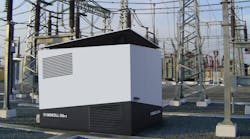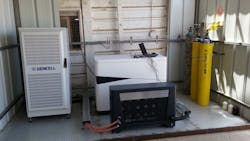Transformational Technologies are Making DERs Possible
When our world faces new and unprecedented threats, we need to be prepared for any scenario. Uninterrupted power is key to virtually every aspect of mission-critical public operations and to maintaining civil and military services, especially in emergencies. Alkaline fuel cells extracting hydrogen to generate long-duration backup power to sustain mission-critical assets can play a significant role in an energy sector in which the distributed energy resource (DER) topology is increasingly common, meeting two key objectives in parallel — on the one hand, fuel cells supply independent power for as long as the grid is not available; on the other hand, the stored energy in the fuel cell can instantly deliver power to the grid to avoid loadshedding and support peak power demands.
The DER business model creates value both for local communities looking to reduce energy costs and retain control and for utilities looking to diversify, increase energy resilience, add customer value, and create new revenue streams. Many utilities are looking to incorporate a distributed model to solve a variety of challenges, including compliance with environmental legislation, relieving pressure on overworked grids and meeting future energy demands.
Benefits to Be Gained from Incorporating Fuel Cells into DER Models
The most important advantage that DERs bring to the table is grid stability. For those seeking highly reliable power, incorporating fuel cells as a key component within a DER environment ensures critical auxiliary power in areas where the grid is unstable.
The fuel cell provides a failsafe backup power source that contributes to the system's reliability as well as its sustainability credentials. A DER model incorporates several sources of power generation, including renewable energies. But because of their weather dependency, wind and solar can only provide intermittent power. As more renewable energy enters the electricity market, introducing higher volatility in supply because of the intermittence of these sources, there is a greater need for stored energy to compensate and provide balance. Fuel cells offer inherent benefits beyond power generation — they can play a role in energy storage and regulating power flow. This makes them an effective DER component for microgrids and other distributed energy systems.
As a modular and scalable technology, additional fuel cells can be easily added to expand the system to meet growing energy demands. Unlike solar and wind farms that require large tracts of land, alkaline fuel cells require substantially less space and are significantly easier to install in urban environments. Producing zero emissions, virtually no noise and no vibrations, fuel cells can be placed either outdoors or within any ventilated building facility. So, in areas vulnerable to hurricanes or severe weather, fuel cells can be placed within protected environments to ensure that there is no disruption in life-saving emergency power, both by maintaining operations through grid outages caused by severe weather incidents and providing power during utility reparations required to repair damages wreaked by storms.
Regulatory Requirements to Integrate Hydrogen Fuel Cells in Distributed Energy Systems
Many regulations, guidelines, codes, and standards have already been established through years of hydrogen use in industrial and aerospace applications. In addition, systems and organizations are already in place to establish codes and standards that facilitate hydrogen and fuel cell commercialization. In the United States, the Department of Energy (DOE) has sponsored the development of permitting tools to facilitate the regulatory process and provide information about relevant codes and standards for hydrogen and fuel cell technologies. In parallel, the NFPA introduced the NFPA 2 Hydrogen Technologies Code to provide a single resource to support the design and approval of hydrogen equipment and facilities. To leverage hydrogen and fuel cells to play a greater role in DER configurations, adherence to the relevant codes and standards, and obtaining and maintaining prerequisite local permits minimizing the safety hazards related to the use of hydrogen are compulsory and will facilitate wider recognition of the valuable role fuel cells can play.
The DOE has developed practices and procedures to ensure safe operation and handling of hydrogen and hydrogen systems throughout the United States. Around the world, efforts are being made to enable the transition to renewable energy sources and regulatory organizations are working with utilities and third parties to identify the current gaps in the standards development process to enable the accelerated incorporation of hydrogen fuel cells and other applications into distributed energy systems.
DERs Introduce Opportunities for Efficiency and Clean Energy Gains on the Grid
The DER topology allows for increased penetration of renewable power to the grid while reducing the grid instability that intermittent renewables cause. Overall, the capacity of a DER to regulate power supply and avoid volatile fluctuations reduces the impact of peak demands on the operational side while also moderating electricity pricing.
Another key value that the DER approach brings to the market is introducing a wider choice of electricity suppliers for consumers, which in the long run will lead to better service. Utilities are gradually recognizing the value of integrating the DER model — taking advantage of the DER's advanced real-time monitoring capabilities to optimize their smart grids, improving efficiency and enabling a variety of improved services that allow customers to better manage their power consumption.
Just as new technologies have enabled positive disruption in many other market segments such as transportation, healthcare, hospitality, and countless others, today's utilities are recognizing that the technologies that DERs bring to the table empower the industry to overcome tough challenges, from grid instability to peak demands to the pressing issue of climate change, which is forcing the world to accelerate our transition away from fossil fuels to clean energy sources such as solar, wind, and hydrogen fuel cells.



